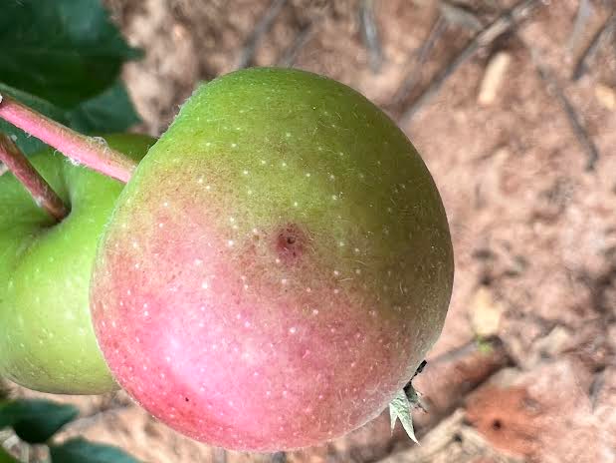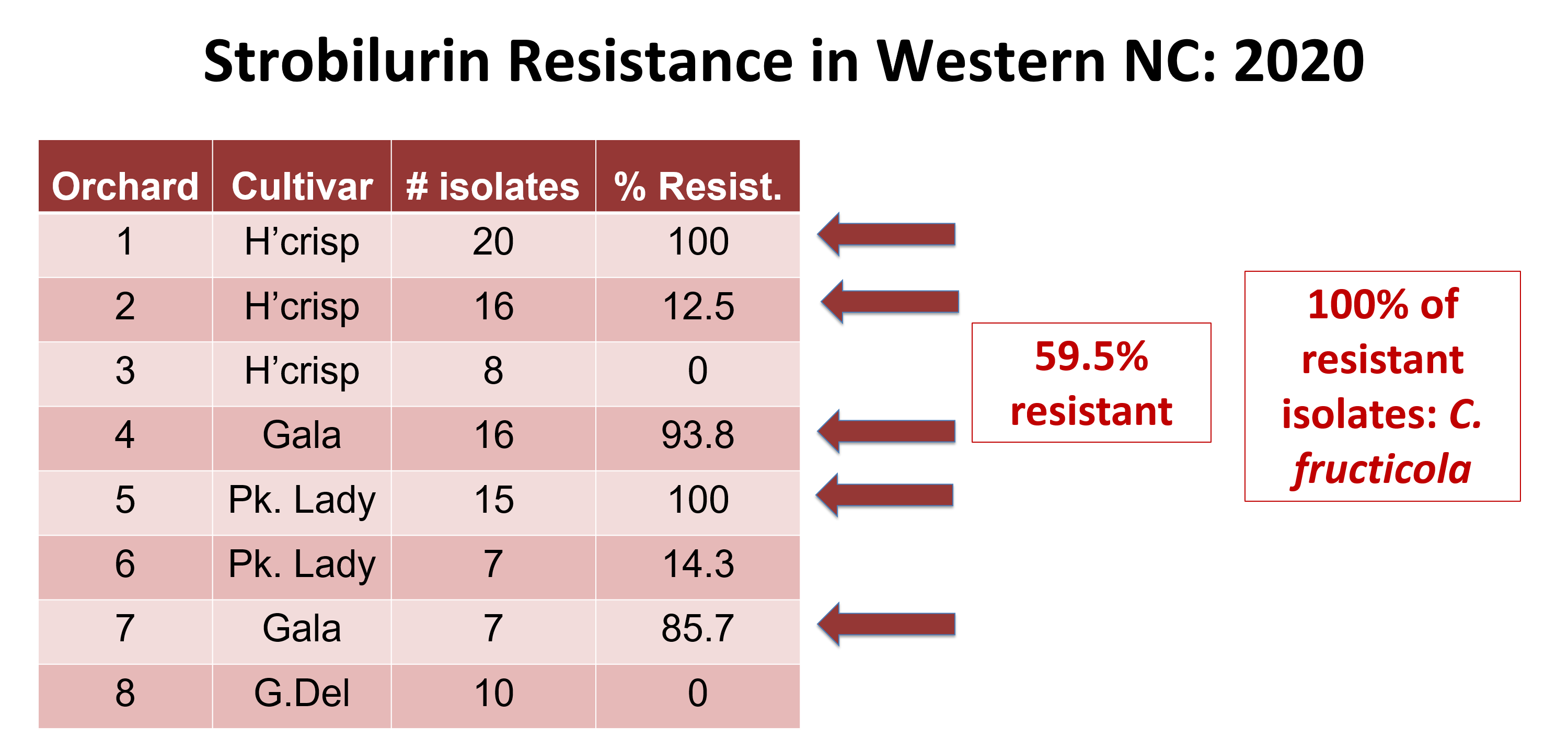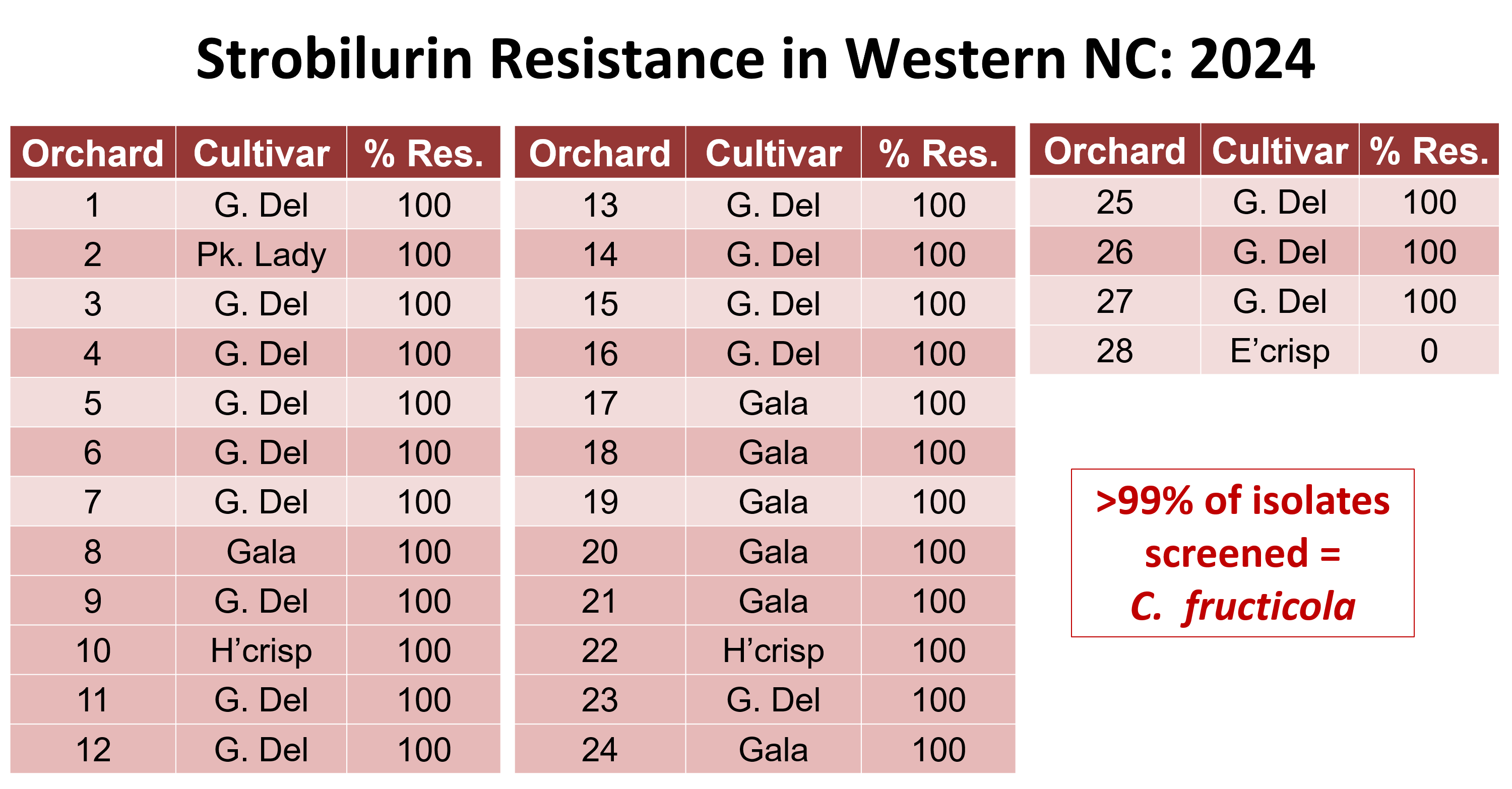Apple Disease Update: Week of June 1, 2025
go.ncsu.edu/readext?1075718
en Español / em Português
El inglés es el idioma de control de esta página. En la medida en que haya algún conflicto entre la traducción al inglés y la traducción, el inglés prevalece.
Al hacer clic en el enlace de traducción se activa un servicio de traducción gratuito para convertir la página al español. Al igual que con cualquier traducción por Internet, la conversión no es sensible al contexto y puede que no traduzca el texto en su significado original. NC State Extension no garantiza la exactitud del texto traducido. Por favor, tenga en cuenta que algunas aplicaciones y/o servicios pueden no funcionar como se espera cuando se traducen.
Português
Inglês é o idioma de controle desta página. Na medida que haja algum conflito entre o texto original em Inglês e a tradução, o Inglês prevalece.
Ao clicar no link de tradução, um serviço gratuito de tradução será ativado para converter a página para o Português. Como em qualquer tradução pela internet, a conversão não é sensivel ao contexto e pode não ocorrer a tradução para o significado orginal. O serviço de Extensão da Carolina do Norte (NC State Extension) não garante a exatidão do texto traduzido. Por favor, observe que algumas funções ou serviços podem não funcionar como esperado após a tradução.
English
English is the controlling language of this page. To the extent there is any conflict between the English text and the translation, English controls.
Clicking on the translation link activates a free translation service to convert the page to Spanish. As with any Internet translation, the conversion is not context-sensitive and may not translate the text to its original meaning. NC State Extension does not guarantee the accuracy of the translated text. Please note that some applications and/or services may not function as expected when translated.
Collapse ▲ Finally some respectable weather this week to start off the last few weeks of spring. Looking at my weather apps this evening, Monday-Thursday look like ideal spray days prior to the rain potentially headed to the region this Friday. Unfortunately I’ve been wrong with forecasts this spring so be sure to keep an eye out.
Finally some respectable weather this week to start off the last few weeks of spring. Looking at my weather apps this evening, Monday-Thursday look like ideal spray days prior to the rain potentially headed to the region this Friday. Unfortunately I’ve been wrong with forecasts this spring so be sure to keep an eye out.
Before providing an update on the state of strobilurin resistance throughout the state, I though it would be a good refresher to go over some early symptoms of Glomerella leaf spot/bitter rot. The photo above shows an early bitter rot (“Glomerella fruit rot”) lesion. The lesion appears as though a lenticel on the fruit is darkened and slightly depressed. If you peel away the skin, there may be light tan browning but no maceration of the flesh or “V” shaped lesion at this point. On yellow or green fruit cultivars there may be a more distinctive red halo that forms.  The photo directly above shows early symptoms of Glomerella leaf spot. Early spots appear purple in color and may be slightly irregular in shape. No concentric rings will yet be present. Often I think this could be mistaken for phytotox or early frogeye leaf spot symptoms (see image below). Note that lesions are not usually concentrated to the midvein or outer leaf margins. Scout for early GLS in the lower canopy (overwintering spores are splashed up) and higher up in the tree where spray coverage may be subpar.
The photo directly above shows early symptoms of Glomerella leaf spot. Early spots appear purple in color and may be slightly irregular in shape. No concentric rings will yet be present. Often I think this could be mistaken for phytotox or early frogeye leaf spot symptoms (see image below). Note that lesions are not usually concentrated to the midvein or outer leaf margins. Scout for early GLS in the lower canopy (overwintering spores are splashed up) and higher up in the tree where spray coverage may be subpar.

Now to move onto strobilurin (FRAC 11) resistance. As of this post there are five fungicides registered for apple that contain strobilurins (forgive me if I missed any generics). These fungicides are:
- Flint Extra (trifloxystrobin) (
- Luna Sensation (trifloxystrobin + fluopyram)
- Merivon (pyraclostrobin + fluxapyroxad)
- Pristine (pyraclostrobin + boscalid)
- Sovran (kresoxim-methyl)
Luna Sensation, Merivon, and Pristine are premixed products where the strobilurin (FRAC 11) is premixed with an SDHI (FRAC 7) fungicide. It is important to note that the only SDHI fungicide we have tested that has a good to great efficacy against Glomerella leaf spot and apple bitter rot is Aprovia (benzovindiflupyr). This means that in the case of the three premixed products above, only the strobilurin (trifloxystrobin or pyraclostrobin) is controlling the bitter rot/Glomerella fruit rot, and Glomerella leaf spot. The following are some critical steps you should take to mitigate the development of FRAC 11/strobilurin resistance in Colletotrichum:
- Always tank mix with multi-site protectant fungicide such as captan, mancozeb, (or ziram if you have any hanging around). The half rate (3 lb/A manzate or 2.5 lb/A Captan 80WDG is fine). Remember mancozeb has a 77 day PHI.
- Apply the highest labeled rate of the strobilurin (FRAC 11).
- Apply strobilurins before an infection event or rain event.
- Do NOT apply alternate row middles. Spray each side of the tree.
- IMPORTANT! Limit strobilurin (FRAC 11) to 4 applications maximum per season. Split them as you’d like: 2 Luna Sensation, 2 Merivon, 4 Merivon, 3 Merivon 1 Flint Extra, etc….. Do Not apply 4 applications of Merivon and then 4 applications of Luna Sensation.
- Do not make more than two consecutive applications of a strobilurin fungicide before switching to a different FRAC group.
Unfortunately isolates and populations of the one of the Colletorichum species causing GLS and bitter rot has developed resistance to strobilurin fungicides. In NC we have two species responsible for Glomerella: Colletotrichum chrysophilum and Colletotrichum fructicola. Usually I don’t feel too much of a need to bring up these two species since for all intents and purposes fungicide management is the same. When I first arrive at NC State, C. chrysophilum was responsible for nearly all GLS infections and nearly all isolates surveyed were sensitive to strobilurin fungicides. Since 2020, we’ve had increasing control failures to the strobilurins and interestingly all of these failures involved infection by C. fructicola.
In 2020, only 8 orchards reported control failures and of these, roughly 60% had resistance to strobilurin fungicides
In 2024, there were 28 orchard blocks that reported control failures as a result of suspected strobilurin resistance. All but one of these orchards had strobilurin fungicide resistance.
It’s important to note in both these cases, sampling is skewed to favor fungicide resistant isolates. Those orchards that didn’t have a major control failure did not have isolates sampled. Also, while the tables say “orchard” these are actually blocks of a particular cultivar within an orchard. An orchard may have had multiple blocks of different cultivars sampled. In summary, most orchard populations in Western NC are likely still sensitive to strobilurins, so it’s important to be vigilant and practice the resistance management recommendations above. If you have strobilurin fungicide resistance confirmed in your orchard blocks or suspect strobiluin resistance, management becomes more difficult but not impossible:
- Mancozeb (until 77 days before harvest) and Captan 80WDG will be your go-to. You may want to tighten up spray intervals to 7 days, particularly during rainy periods and close to harvest.
- While it doesn’t replace a strobilurin, Aprovia has performed well in our GLS field trials. Consider forgoing Aprovia during the primary scab season and apply it before a rainy week. Aprovia does have a 30 day PHI.
- Omega applied at its highest labeled rate has performed well against bitter rot in other states. We are testing it for GLS control this year. Again, well timed applications prior to extended rain periods is where I’d position Omega. Omega has a 28 day PHI.
Now for some spray suggestions this week. If you have a partial or full crop, I’d go with Captan 80WDG (2.5-3 lb/A). I’m still hearing reports of powdery mildew in some areas. Gatten or Torino are mildew specific fungicides that are worth considering. Sulfur (Microthiol Disperss) is another option, but I’d refrain from applying when the temps are 83-85 F or above.




